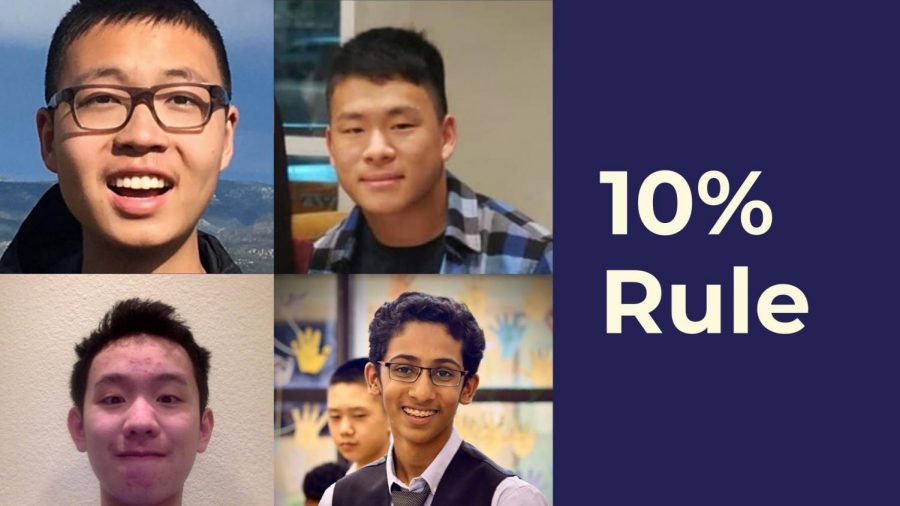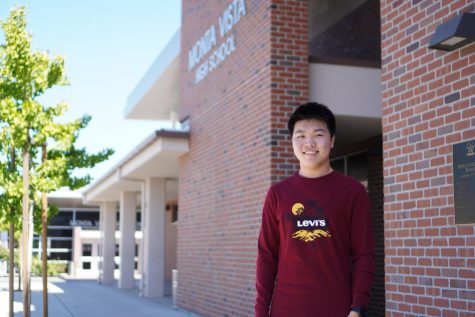Modeling the future: MVHS students advance to finalist symposium for national mathematical modeling competition
April 10, 2020
Each year, the Actuarial Foundation hosts the Modeling the Future (MTF) Challenge, a competition for high school students centered around analyzing data through mathematical models. Junior Parth Asawa, junior Richard Liu, junior Eric Zhang and senior Brandon Guo formed a team called “10% Rule” and participated in the competition, and the group was selected as one of 11 finalist teams out of a total of 170 teams that competed.
The MTF Challenge develops a prompt each year for students to analyze and eventually make recommendations about. In 2018-19, the MTF Challenge prompt was related to curing chronic kidney disease. One group decided to analyze how different artificial kidneys were impacted by different chronic kidney diseases. For the 2019-20 school year, the MTF Challenge prompt is centered around how climate change and water access will affect the agricultural industry in the coming decades. Students were encouraged to propose ideas about insurance or public policy changes that could be made to mitigate risks they predicted in the industry.
Before actually having the opportunity to build mathematical models and analyze data, each team in the MTF Challenge must pass a qualifying phase by taking a preliminary exam consisting of 25 statistics questions. The qualifying phase took place in November, and 10% Rule was able to complete the round in a single sitting of two to three hours.
“Most of the questions you could actually answer if you took an AP Statistics class [at] MVHS, because they’re fairly simple,” Asawa said. “The later half of the qualifying set was making recommendations based on the analysis you had done previously. So in terms of mathematical difficulty, it wasn’t really that far past AP Statistics, it was just testing your ability to actually explain mathematics and how you can make recommendations based on that.”
10% Rule moved past the qualifying phase and entered the project phase in mid-December. At this point, the team was assigned an actuarial mentor, a professional who works in the field of statistics and data analysis: Herschel Day, Professor of Mathematics at University of Wisconsin Eau Claire. The team’s next step was to narrow down its focus within the MTF Challenge’s prompt of impacts on agriculture. The prompt was broken into several parts for teams to narrow down: teams decided on a crop and region to analyze within the agricultural industry, as well as what impacts of climate change they wanted to explore.
10% Rule settled on choosing Southern Minnesota as its region and corn as its crop. By Feb. 28, the team needed to write a 25-page report including mathematical models and policy recommendations based on findings. Within 10% Rule, Zhang and Guo focused on refining algorithms and models to analyze agriculture data while Asawa and Liu focused on researching past studies and providing context for the models.
Asawa and Liu consulted 27 different sources when researching Minnesota’s agriculture. They examined topics such as employment, state revenue and past histories of agricultural loss in order to understand how climate change could affect the agricultural industry.
Guo and Zhang had moments where they were unsure what algorithms to use in their modeling since the competition was very open-ended. To Guo, the most difficult aspect of his work involved presenting the algorithms the team used in a clear way. In addition, the team needed to clean up datasets it obtained from the government by manually processing the data. As the team continued to refine its models, sections of the report were put on hold since they depended on the results of the analysis.
Throughout the process of writing its report, 10% Rule found value in having an actuarial mentor matched to the team. Guo shares that Day helped the team with sanity checks and confirmed that the models were on the right track. Despite not having much progress when the team met up with Day, he provided them with guidance about how to move forward.
10% Rule found the MTF Challenge to be a rewarding way to learn about applying statistics and data analysis to real-world data. In fact, Asawa recommends the competition to students who are taking AP Statistics in school, as he believes the challenge can broaden one’s horizons about how statistics skills in the classroom can be applied to real situations.
“A lot of school [classes] that people learn, it’s formulaic, and it’s very repetitive,” Guo said. “And there’s a reason for that because practice does make people better. But this is definitely more open-ended … because the idea is that there’s never one best model. So it’s all about trying to balance and trying to find the perfect one, and there may be many perfect ones.”


















